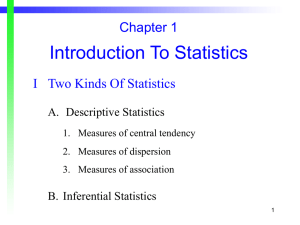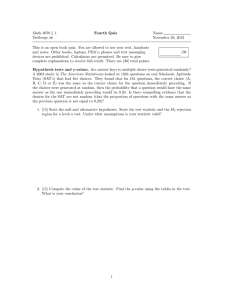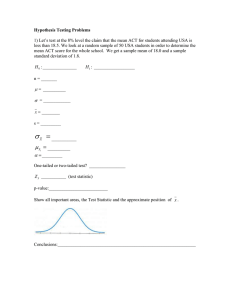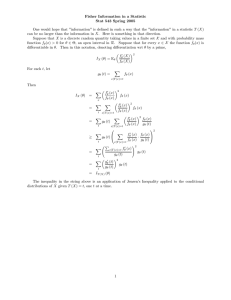Different types of upper limits in case of a non
advertisement
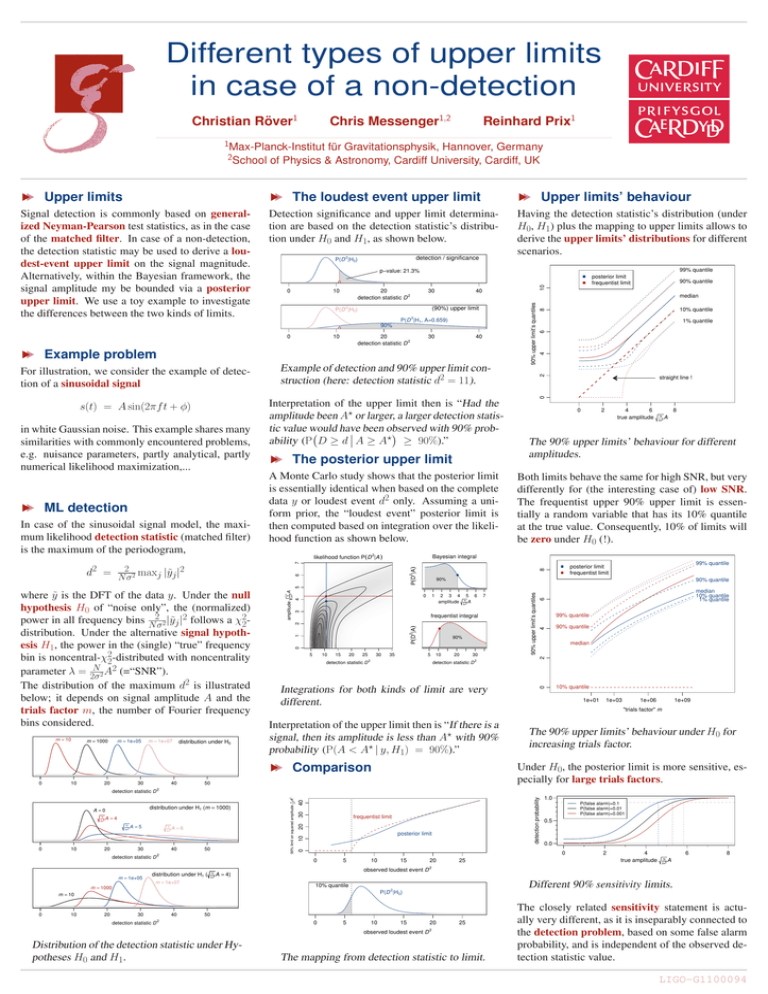
Different types of upper limits in case of a non-detection Christian Röver1 Chris Messenger1,2 Reinhard Prix1 1Max-Planck-Institut für Gravitationsphysik, Hannover, Germany 2School of Physics & Astronomy, Cardiff University, Cardiff, UK ·· Upper limits ·· The loudest event upper limit ·· Upper limits’ behaviour Signal detection is commonly based on generalized Neyman-Pearson test statistics, as in the case of the matched filter. In case of a non-detection, the detection statistic may be used to derive a loudest-event upper limit on the signal magnitude. Alternatively, within the Bayesian framework, the signal amplitude my be bounded via a posterior upper limit. We use a toy example to investigate the differences between the two kinds of limits. Detection significance and upper limit determination are based on the detection statistic’s distribution under H0 and H1, as shown below. Having the detection statistic’s distribution (under H0, H1) plus the mapping to upper limits allows to derive the upper limits’ distributions for different scenarios. detection / significance P(D 2|H0) 99% quantile p−value: 21.3% 90% 10 10 median P(D 2|H1, A=0.659) 20 detection statistic D 2 30 40 ·· Example problem Example of detection and 90% upper limit construction (here: detection statistic d2 = 11). s(t) = A sin(2πf t + φ) Interpretation of the upper limit then is “Had the amplitude been A⋆ or larger, a larger detection statistic value would have with 90% prob been observed ability (P D ≥ d A ≥ A⋆ ≥ 90%).” 1% quantile straight line ! 0 For illustration, we consider the example of detection of a sinusoidal signal 10% quantile 8 (90%) upper limit P(D 2|H0) 0 40 6 30 4 20 detection statistic D 2 90% quantile 2 10 90% upper limit’s quantiles 0 posterior limit frequentist limit in white Gaussian noise. This example shares many similarities with commonly encountered problems, e.g. nuisance parameters, partly analytical, partly numerical likelihood maximization,... ·· ML detection A Monte Carlo study shows that the posterior limit is essentially identical when based on the complete data y or loudest event d2 only. Assuming a uniform prior, the “loudest event” posterior limit is then computed based on integration over the likelihood function as shown below. likelihood function P(D 2|A ) 2 4 6 true amplitude 8 N 2σ2 A The 90% upper limits’ behaviour for different amplitudes. Both limits behave the same for high SNR, but very differently for (the interesting case of) low SNR. The frequentist upper 90% upper limit is essentially a random variable that has its 10% quantile at the true value. Consequently, 10% of limits will be zero under H0 (!). Bayesian integral 99% quantile 8 posterior limit frequentist limit 90% 90% quantile m = 10 m = 1000 m = 1e+05 m = 1e+07 distribution under H0 90% 0 1 P(D2|A) 2 frequentist integral 10 15 20 25 detection statistic D 30 35 5 2 10 20 30 10 20 30 40 6 detection statistic D 2 Integrations for both kinds of limit are very different. 10% quantile 1e+01 1e+03 1e+06 1e+09 "trials factor" m Interpretation of the upper limit then is “If there is a signal, then its amplitude is less than A⋆ with 90% probability (P(A < A⋆ | y, H1) = 90%).” ·· Comparison 0 90% quantile median 0 5 median 10% quantile 1% quantile 99% quantile 4 7 3 5 6 N A 2σ2 2 2 3 4 amplitude 4 1 90% upper limit’s quantiles 0 N 2σ2 amplitude where ỹ is the DFT of the data y. Under the null hypothesis H0 of “noise only”, the (normalized) power in all frequency bins N2σ2 |ỹj |2 follows a χ22distribution. Under the alternative signal hypothesis H1, the power in the (single) “true” frequency bin is noncentral-χ22-distributed with noncentrality N A2 (=“SNR”). parameter λ = 2σ 2 The distribution of the maximum d2 is illustrated below; it depends on signal amplitude A and the trials factor m, the number of Fourier frequency bins considered. A 5 6 d2 = N2σ2 maxj |ỹj |2 P(D2|A) 7 In case of the sinusoidal signal model, the maximum likelihood detection statistic (matched filter) is the maximum of the periodogram, ·· The posterior upper limit 0 The 90% upper limits’ behaviour under H0 for increasing trials factor. Under H0, the posterior limit is more sensitive, especially for large trials factors. 50 0 10 20 A =5 N 2σ2 30 40 detection statistic D m = 1e+05 A =6 50 2 40 frequentist limit posterior limit distribution under H1 ( 5 m = 1e+07 10 10 20 15 20 25 0.5 0.0 2 4 true amplitude 6 N 2σ2 8 A Different 90% sensitivity limits. 10% quantile 2 P(D |H0) m = 10 0 P(false alarm)=0.1 P(false alarm)=0.01 P(false alarm)=0.001 observed loudest event D 2 A = 4) m = 1000 1.0 0 0 N 2σ2 detection probability N 2σ2 30 A =4 20 N 2σ2 10 A =0 0 distribution under H1 (m = 1000) 90% limit on squared amplitude 2σN2A 2 detection statistic D 2 30 40 50 detection statistic D 2 0 5 10 15 20 25 observed loudest event D 2 Distribution of the detection statistic under Hypotheses H0 and H1. The mapping from detection statistic to limit. The closely related sensitivity statement is actually very different, as it is inseparably connected to the detection problem, based on some false alarm probability, and is independent of the observed detection statistic value. LIGO-G1100094


